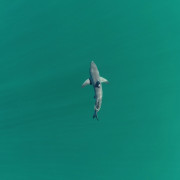- Science News
- Climate action
- Antarctic extreme events: ‘All-time records are being shattered not from decades ago, but from the last few years and months’
Antarctic extreme events: ‘All-time records are being shattered not from decades ago, but from the last few years and months’
By Prof Martin Siegert, University of Exeter (Cornwall)

42 governments around the world have agreed to protect Antarctica’s environment. While the main focus has been on operational activities in Antarctica, global warming caused by fossil-fuel burning by these (and other) countries has left Antarctica on the brink of irreversible change.
A new study published in Frontiers in Environmental Science has revealed that, in addition to the influence of gradual global heating, Antarctica is increasingly affected by extreme environmental events; a recognized and predicted outcome of our heating world. Writing as part of Frontiers’ guest editorials series, the study’s lead author – Prof Martin Siegert, deputy vice chancellor of the University of Exeter (Cornwall) – discusses how without there being a rapid shift to net-zero greenhouse gas emissions by 2050, the Antarctic environment will experience ever more drastic changes.
Extreme weather events appear to be increasing in size and occurrence, with disastrous outcomes for lives and livelihoods, whether it be from intense heatwaves, severe droughts, deluge rainfall, flooding, and deep storms. All-time records are being shattered not from those of decades ago, but from the last few years and months, exemplifying the human-induced forces we are subjecting our planet to. July 2023 is measured as the hottest month ever recorded, preceded by the hottest June on record.
While much attention has been given to how extreme events impact the most populated regions, given Earth’s environmental system involves linked global processes we must also understand how events occur and affect remote regions, as they may have global consequences.
Antarctica is such a place – remote from society yet influentially connected to the world’s environment that it relies on for survival. For example, Antarctica acts to cool our planet by reflecting solar radiation back to space by virtue of the brightness of its snow surface. In addition, it stores vast quantities of freshwater that if released to the ocean would rise sea level by tens of meters and interfere with saline-driven ocean currents that transfer heat around the planet.

Download original article (pdf)
Alarming numbers
In our new article, we reveal that some of the world’s most extreme events have occurred in Antarctica, and they too are breaking records. The world’s largest ever heatwave (38.5C above normal) occurred in east Antarctica in March 2022, caused by an atmospheric river of warmth stemming from Australia and penetrating across the southern ocean and through the polar vortex (a permanent stratospheric cyclonic flow of air) that normally prevents such movement.
At the center of East Antarctica, where the temperature should have been close to -50C it was nearer to -10C. If the heatwave had occurred in summertime, it may have been possible for the surface of the ice sheet to melt right up to the summit – something that has never happed for hundreds of thousands of years.
The greatest temperature ever recorded on Antarctica occurred in February 2020, when the mercury hit 18.3C. Such temperatures obviously melt snow and ice more quickly, leading to meltwater ponding on the ice, which we know can lead to sudden alteration to glacier conditions.
Several floating ice shelves – the massive slabs of ice that push back grounded ice from flowing into the ocean – have catastrophically broken up in a matter of days because of such melting.
In the ocean, 19 marine heatwaves have been recorded between 2002 and 2018. Warm ocean water means that sea-ice – the thin layer of ice on the polar ocean that acts to reflect sunlight back to space and keep the planet cool – will either melt (in summer) or fail to form (in winter).

Human impact on Antarctica not a new phenomenon
So it is sadly not surprising, but alarming nonetheless, that this year’s winter sea-ice growth is the lowest on record, continuing a noticeable trend since 2017. The danger is that the Antarctic sea ice is starting to behave like the Arctic, with sustained loss of ocean cover and consequent absorption of solar radiation. In the Arctic this has led to regional warming four times faster than the global average. If Antarctica behaves in this way, the environmental damage seen to date will likely be insignificant by comparison.
Human impacts to wildlife in Antarctica began as soon the continent was discovered. Sealine and whaling – marine ‘resources’ that drove the first oil boom – led to the near extinction of large marine mammals. The only reason they survived is because the whalers could not find them and their slaughter became uneconomic. International agreements to ban and limit whaling have seen numbers return, however, which is testament to how international agreements can protect and preserve natural polar systems.
42 countries have pledged to preserve the Antarctic environment through a ‘comprehensive’ protocol to the Antarctic Treaty. While much has been achieved to limit direct environmental damage by field operations, significant impacts are now being felt in Antarctica from the extreme events caused by fossil-fuel burning. These countries will now have to examine and appreciate that their own emissions are damaging Antarctica in ways we reveal, and that continuing to emit greenhouse gasses will not allow for the protection of Antarctica.
Prof Martin Siegert is an award-winning Antarctic glaciologist and climate scientist. Last year he was appointed by the University of Exeter to strategically lead its operations in Cornwall as its deputy vice-chancellor. Siegert has published more than 300 scientific papers and also edited the second edition of Antarctic Climate Evolution, which details the history of the continent over the past 60 million years. He is currently field chief editor of the journal Frontiers in Environmental Science.
REPUBLISHING GUIDELINES: Open access and sharing research is part of Frontiers’ mission. Unless otherwise noted, you can republish articles posted in the Frontiers news site — as long as you include a link back to the original research. Selling the articles is not allowed.







